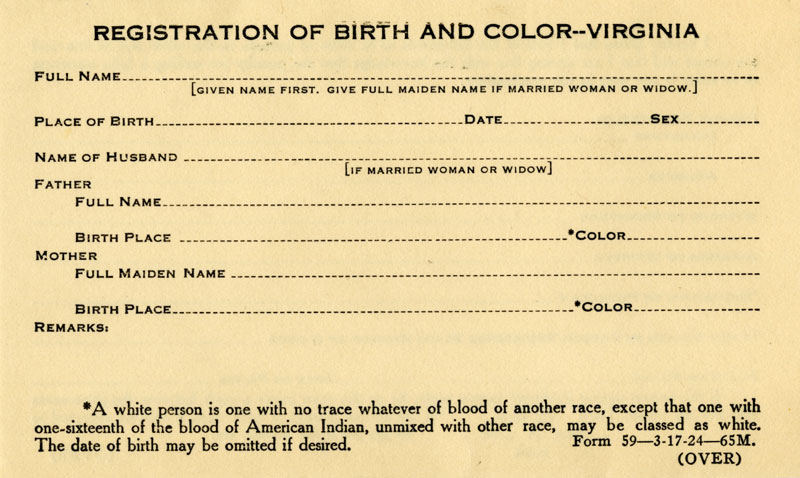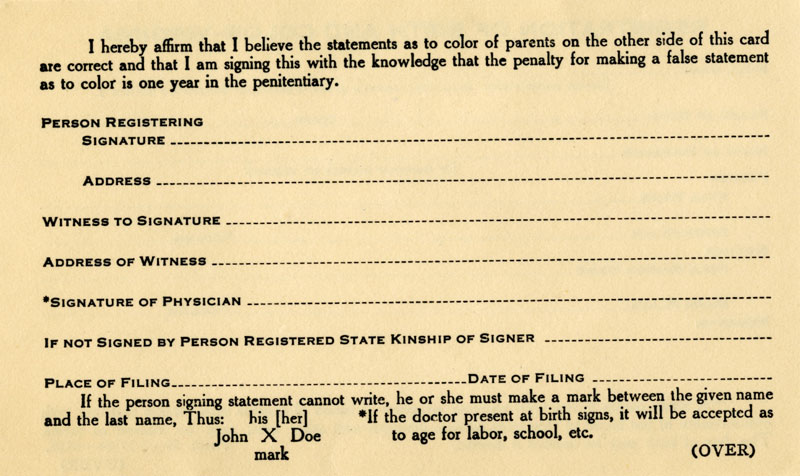Virginia’s Attempt to Adjust the Color Problem
The American Journal of Public Health
Volume 15, Number 2 (1925)
pages 111-115
W. A. Plecker, M.D., Fellow A.P.H.A.
State Registrar of Vital Statistics, Richmond, Virginia
Read at the joint session of the Public Health Administration and Vital Statistics Sections of the American Public Health Association at the Fifty-third Annual Meeting at Detroit, Michigan, October 23, 1924.
The settlers of North America came not as did the Spanish and Portuguese adventurers of the southern continent, without their women, bent only on conquest and the gaining of wealth and power; but bringing their families, the Bible, and high ideals of religious and civic freedom.
They came to make homes, to create a nation, and to found a civilization of the highest type; not to mix their blood with the savages of the land; not to originate a mongrel population combining the worst traits of both conquerors and conquered.
All was well until that fateful day in 1619 when a Dutch trader landed twenty negroes and sold them to the settlers, who hoped by means of slave labor to clear the land and develop the colony more quickly.
Few paused to consider the enormity of the mistake until it was too late. From this small beginning developed the great slave traffic which continued until 1808, when the importation of slaves into America was stopped. But there were already enough negroes in the land to constitute them the great American problem. Two races as materially divergent as the white and the negro, in morals, mental powers, and cultural fitness, cannot live in close contact without injury to the higher, amounting in many cases to absolute ruin. The lower never has been and never car be raised to the level of the higher.
This statement is not an opinion based on sentiment or prejudice, but is an unquestionable scientific fact. Recently published ethnological studies of history lead to this conclusion, as do the psychologic tests of negro and negroid groups, especially the tests made by the United States Army for selective service in the World War. It is evident that in the hybrid mixture the traits of the more primitive will dominate those of the more specialized or civilized race. It is equally obvious that these culturally destructive characteristics are hereditary, carried in the germ plasm, and hence they cannot be influenced by environmental factors such as improved economic, social and educational opportunities. On the contrary, such opportunities often accelerate the inevitable decadence. Dr. A. H. Estabrook in a recent study, made for the Carnegie Foundation, of a mixed group in Virginia many of whom are so slightly negroid as to be able to pass for white, says, ” School studies and observations of some adults indicate the group as a whole to be of poor mentality, much below the average, probably D or D- on the basis of the army intelligence tests. There is an early adolescence with low moral code, high incidence of licentiousness and 21 per cent of illegitimacy in the group.”
When two races live together there is but one possible outcome, and that is the amalgamation of the races. The result of this will be the elimination of the higher type, the one on which progress depends. In the mixture the lower race loses its native good qualities which may be utilized and developed in the presence of a dominant race…
…Let us return now to our own country, and, as we are considering Virginia, to that state in particular. There are about twelve million negroes of various degrees of admixture in the Union today. Of the population of Virginia, nearly one-third is classed as negro, but many of these people are negroid, some being near-wnite, some having actually succeeded in getting across into the white class.
The mixed negroes are nearly all the result of illegitimate intercourse. The well known moral laxity resulting from close contact of a civilized with a primitive race makes illegitimate intermixture an easy matter. This is illustrated by the fact that the illegitimate birth-rate of Virginia negroes is thirty-two times that of Rhode Island, while the District of Columbia rate is thirty-seven times, and that of Maryland forty-six times.
In the days when slavery was still a blight upon our state, it was quite a common occurrence for white men to father children born to the negro servants. The history, as related to me, of at least one colony of people known as “Issue” or ” Free Issue,” now spread over several counties, is that they originated in part in that manner.
It was considered undesirable to retain these mulattoes on the place, bearing the family name, and a number from one county were given their freedom and colonized in a distant county. These intermarried amongst themselves and with some people of Indian-negro-white descent, and received an additional infusion of white blood, either illegitimately or by actual marriage with low-grade whites…
…In the lifetime of some now living we may expect the present twelve million colored population to increase to twenty or possibly thirty millions, and that perhaps to one hundred millions during the next century, to say nothing of the prolific Mongolians who are already firmly established upon our western coast. With the competition of this large number of people of low ideals and low standards of living, and the great effort to secure the means of maintaining a family up to the desired standard, the white population will to that extent be crowded out.
Virginia has made the first serious attempt to stay or postpone the evil day when this is no longer a white man’s country. Her recently enacted law “for the preservation of racial integrity” is, in the words of Major E. S. Cox, “the most perfect expression of the white ideal, and the most important eugenical effort that has been made during the past 4,000 years.” Of course this law will not prevent the illegitimate mixture of the races, although a law requiring the father to share with the mother the responsibility of the birth would have a deterring effect. When more than one man is involved, all should be held equally responsible in sharing the cost, as I am informed is the case in Norway.
But it is possible to stop the legal intermixture, and that Virginia has attempted to do in the above mentioned law, which defines a white person as one with “no trace whatsoever of blood other than Caucasian,” and makes it a felony punishable by confinement for one year in the penitentiary to make a willfully false statement as to color.
Clerks are not permitted to grant licenses for white persons to marry those with any trace of colored blood. It is needless to call attention to the sad plight of a white person who is thus imposed upon or of a white woman who under such circumstances would give birth to a child of marked negro characteristics, as will occur from time to time under Mendel’s law.
The new law places upon the office of the Bureau of Vital Statistics much additional work, but we believe it will be a strong factor in preventing the inter’marriage of the races and in preventing persons of negro descent from passing themselves off as white…
Read the entire article here.



